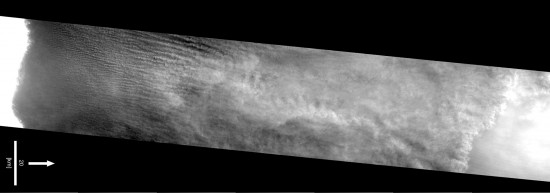
Martian dust storm in Hellas Planitia. Note helical vortices in the southern part (left). Credit: NASA, JPL, Malin Space Science.
Jul 24, 2015
Wispy clouds are seen hundreds of kilometers above Mars.
Recently, planetary scientists announced the discovery of giant plumes reaching up to 250 kilometers from the Martian surface. Agustin Sanchez-Lavega of the Universidad del País Vasco in Spain wrote in the journal, Nature:
“One idea we’ve discussed is that the features are caused by a reflective cloud of water-ice, carbon dioxide-ice or dust particles, but this would require exceptional deviations from standard atmospheric circulation models to explain cloud formations at such high altitudes.”
Dust particles could be the answer. The dust storms that occasionally engulf an entire hemisphere of Mars are discussed several times in these pages. They are caused by dust devils—really tornado-like whirlwinds whose tops are higher than Mt. Everest—that appear to draw surface dust up through thousands of funnels and carry it for hundreds of kilometers. NASA scientists assume that synchrotron radiation (detected at the top of the funnels) is caused by electric charge build up in the sand grains that subsequently discharged as lightning, but that may not be the case.
In March 2005 Electric Universe advocates wrote about the surprising discovery of dust devils spinning across the Martian deserts. Cameras in space, as well as on the Martian surface returned many images of large, glowing funnels raking across the flatlands, leaving darkened trackways behind.
Most likely it is those “sky high” vortices that are forcing the plumes to rise so far above the Red Planet. What causes Martian dust storms and why are they electrified? The air is 100 times thinner on Mars and averages 75 degrees colder than Earth. The environment appears to be bone dry, with only some suggestive experiments by the Phoenix lander to indicate the possible presence of water ice. Yet Martian dust storms are larger than any seen on Earth. Occasionally, when Mars is closest to the Sun, dust obscures the whole planet.
When NASA studied dust devils in the Arizona desert in order to understand more about the ones that have been seen on Mars, they found an electric field of up to 10,000 volts per meter associated with dust devils on Earth. The normal fair weather electric field at the Earth’s surface measures between 100 and 400 volts per meter. This suggests that dust devils on both Earth and Mars are atmospheric electric discharge phenomena similar to the electric breezes produced by “ionic wind” air purifiers.
In the Electric Universe theory, no collisions from bouncing sand grains are necessary. Charge separation already exists in the atmosphere. Without clouds like those on Earth to send lightning down to ground level, the electric discharges on Mars form giant whirlwinds that are part of an interplanetary electrical circuit.
Stephen Smith












